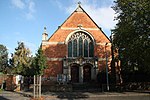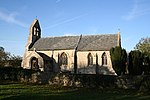Little Hale
Civil parishes in LincolnshireNorth Kesteven DistrictUse British English from January 2014Villages in Lincolnshire

Little Hale is a hamlet and civil parish in the North Kesteven district of Lincolnshire, England. It is situated 5 miles (8 km) south-east from the town of Sleaford, and directly south from the larger villages of Great Hale and Heckington. Adjacent villages include Burton Pedwardine, Great Hale and Helpringham. Little Hale, a village of approximately 60 houses, lies on the eastern western edge of the Lincolnshire Fens.
Excerpt from the Wikipedia article Little Hale (License: CC BY-SA 3.0, Authors, Images).Little Hale
Main Road, North Kesteven Little Hale
Geographical coordinates (GPS) Address Nearby Places Show on map
Geographical coordinates (GPS)
| Latitude | Longitude |
|---|---|
| N 52.961008 ° | E -0.296524 ° |
Address
Main Road
Main Road
NG34 9BA North Kesteven, Little Hale
England, United Kingdom
Open on Google Maps








